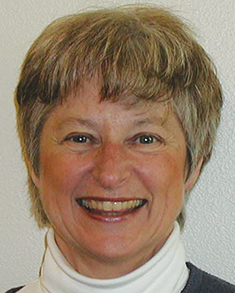Taylor honored for work on protein kinase A
Susan S. Taylor, professor of chemistry and biochemistry as well as pharmacology at the University of California, San Diego, has won the 2017 American Society for Biochemistry and Molecular Biology Earl and Thressa Stadtman Distinguished Scientist Award. Taylor has done pioneering structural studies of protein kinase A, revealing fundamental themes for all protein kinases.

“I was thrilled and deeply honored to receive the news from Natalie Ahn that I had been selected for the 2017 Earl and Thressa Stadtman Award. Although I have never worked in Dr. Earl Stadtman’s lab, I have always considered him to be a close friend and would visit with him every time that I came to NIH. Earl and Thressa are both role models for future generations.”
— Susan S. Taylor
In 1991, the Taylor group solved the structure of the catalytic subunit of PKA, which proved to be a prototype for nearly all other protein kinases. Her structural analyses uncovered detailed insights into the mechanisms of ATP and peptide binding and phosphate transfer as well as the roles of autophosphorylation and open versus closed conformations. These studies were complemented by her structural analyses for the type 1α and type IIβ regulatory subunits of PKA, which revealed how cAMP is recognized by two tandem binding sites linked allosterically.
The Taylor group then solved the structures of PKA holoenzyme. This work showed how the regulatory subunit inhibits the catalytic subunit by forming an R2C2 holoenzyme complex where two regulatory subunits block the activity of each catalytic subunit. Sequential and allosteric binding of cAMP to the regulatory subunit initiates conformational changes that lead to the dissociation of the catalytic activity of the C-subunit, which can then bind its substrate. P. Boon Chock of the National Heart, Lung and Blood Institute states that this molecular switch is a fundamental regulator of many biological events and defines a mechanism that is adapted in different ways by protein kinases.
Next, the Taylor group began comparing kinases and found another unifying theme: the hydrophobic spine that is present in all active protein kinases. This feature has proven invaluable for inhibitor development. In addition, Taylor collaborated with the late Roger Tsien of UCSD to measure cAMP levels and PKA activity in living cells. From this, she discovered a nuclear export signal in the protein kinase inhibitor.
With the later discovery of proteins known as AKAPs and the mechanism of allosteric activation of the RAF kinase, the Taylor group solidified themselves as leaders in the field. “Her research provides fundamental breakthroughs in our understanding of the catalytic action and regulation of protein kinases,” states Chock.
The Stadtmans, for whom this award was named, exemplified scientific research, mentorship and science statesmanship. Mark A. Lemmon of the Yale University Cancer Biology Institute wrote in his letter of support for Taylor’s nomination, “Susan Taylor was a frequent visitor to the Stadtmans’ laboratories at (the National Institutes of Health), and indeed has described herself as ‘a surrogate member of Earl’s family.’”
Taylor received a bachelor’s degree in chemistry from the University of Wisconsin–Madison and a Ph.D. in physiological chemistry from the Johns Hopkins University. She then held two postdoctoral positions at the Medical Research Council Laboratory of Molecular Biology in the U.K. and UCSD.
Among other awards, Taylor has won the ASBMB William C. Rose Award, an American Association for the Advancement of Science fellowship and the Federation of American Societies for Experimental Biology Excellence in Science Award. She also served as president of the ASBMB.
She was elected into the National Academy of Sciences, the National Academy of Medicine, and the American Academy of Arts and Sciences and served on the fellowships advisory panel for the Packard Foundation and the General Motors Cancer Research Foundation Awards Assembly.
Enjoy reading ASBMB Today?
Become a member to receive the print edition four times a year and the digital edition monthly.
Learn moreGet the latest from ASBMB Today
Enter your email address, and we’ll send you a weekly email with recent articles, interviews and more.
Latest in People
People highlights or most popular articles

Sketching, scribbling and scicomm
Graduate student Ari Paiz describes how her love of science and art blend to make her an effective science communicator.

Embrace your neurodivergence and flourish in college
This guide offers practical advice on setting yourself up for success — learn how to leverage campus resources, work with professors and embrace your strengths.

Survival tools for a neurodivergent brain in academia
Working in academia is hard, and being neurodivergent makes it harder. Here are a few tools that may help, from a Ph.D. student with ADHD.

Quieting the static: Building inclusive STEM classrooms
Christin Monroe, an assistant professor of chemistry at Landmark College, offers practical tips to help educators make their classrooms more accessible to neurodivergent scientists.

Hidden strengths of an autistic scientist
Navigating the world of scientific research as an autistic scientist comes with unique challenges —microaggressions, communication hurdles and the constant pressure to conform to social norms, postbaccalaureate student Taylor Stolberg writes.

Richard Silverman to speak at ASBMB 2025
Richard Silverman and Melissa Moore are the featured speakers at the ASBMB annual meeting to be held April 12-15 in Chicago.

